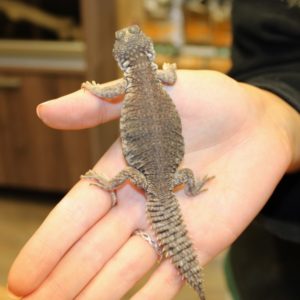Copyright 2021 Evolution Reptiles
All rights reserved.
Copyright 2025 Evolution Reptiles
All rights reserved.
All rights reserved.
Moroccan Uromastyx are true desert lizards that spend a large proportion of their day basking in the sun. They originate from Morocco, Libya, Niger and Sudan establishing themselves in hilly, rocky areas with good shelter and accessible vegetation. Like many reptiles, these lizards’ colours change according to the temperature; during cool weather they appear dull and dark but the colours become lighter in warm weather, especially when basking; the darker pigmentation allows their skin to absorb sunlight more effectively.
Uromastyx make great pets, as they are inquisitive and good natured. They grow up to 40cm long and develop lovely colours, from yellows to reds although juveniles start off grey. Uromastyx are herbivorous, making them a great choice if you aren’t keen on offering live insects.
Uromastyx are active lizards so require plenty of room. A 48x24x24″ vivarium would be suitable, as it gives them plenty of floor space. They love to bask on rocks, but make sure the rocks are very secure and placed on the floor of the vivarium not the substrate as they will dig under them! Provide them with plenty of different hides so they are always close to a secure hiding place; this will make them feel more confident, and you should see them more often. It is a good idea to fill one of the hides with the substrate so they have to dig their way in.
Temperature is vitally important to all reptiles as they cannot produce their own body heat and need to be kept within a suitable range to help the body function correctly.

Uromastyx require a temperature range of up to 45°C (113°F) in the basking area, down to approximately 30°C (86°F) in the cooler area. This will provide the lizard with a temperature gradient across the vivarium, allowing them to choose the most suitable temperature at all times. At night the temperature can be allowed to drop as low as 16°C (61°F).
The day time temperatures can be achieved by using a halogen basking light (the heat is more focused than a regular light) fitted to a dimming thermostat. Using fans to increase ventilation can be a good idea as this helps keep the rest of the vivarium cooler.
It is very important to know what the temperature is, so check regularly with an accurate digital thermometer. Ideally use two maximum/minimum thermometers per vivarium (one at each end of the vivarium), or you can use an in/out, max/min thermometer and place 1 sensor at each end. Do not guess or take temperature by hand (if it feels warm or cold), as this is not accurate enough.
Uromastyx – as diurnal basking lizards – require UV light to help use calcium from their diet and prevent metabolic bone disease. We recommend using a T5 lamp with 10-12% UVB. UV lights should be mounted directly above the lizards, and not on the back or side of the vivarium.
A simple 12-14 hour light cycle is ideal for a Uromastyx, although if you intend to breed them you will need to hibernate them. Contact us for more information.
We tend to use a substrate that is dry and easy for the Uromastyx to dig in, although if you have the space it’s worth using one of the soil based substrates that can be kept slightly damper below the surface. There are also clay mixes available that can provide a deep, hardened substrate that the uromastyx can burrow into.
We only offer water once a week as it is not usually taken and increased humidity can cause a few issues. They receive most of their water from their food.
Uromastyx are a herbivorous lizard. Plants that can be offered include: lollo rossa, endive, radicchio, corn salad (lambs lettuce), rocket, finely shredded carrot, water cress, dandelion, clover, plantain, convolvulus, polygonum(russian vine), chick weed, alpine plants(adjuga), sprouted seeds, alfalfa, mung beans, radish, chick peas, lentils, soya, wheat, dry seeds, parakeet mix, chopped hay, hibiscus flowers, or gazania flowers. DO NOT feed spinach, cabbage, iceberg lettuce and buttercup. Try to offer a variety to keep a balanced diet. Regular use of vitamin/mineral supplements is very important to prevent problems such as metabolic bone disease, which is a calcium deficiency. This is a serious condition and can occur very rapidly in young lizards that are growing quickly.
Latest recommendations suggest the use of a multivitamin and mineral supplement twice weekly and a calcium supplement daily. The supplements should be dusted onto their livefood and salad.
Uromastyx will also take a few insects, morio and mealworms being the preferred although not strictly required. Too many insects will make your uromastyx sick, although the occasional treat helps to make friends with your lizard.
Uromastyx have great characters and are fairly easy to care for. Their bright colours as adults make them very attractive. They are perfect if you are not fond of using livefoods!
If you love lizards but not the live insects then these are the lizards you have been looking for!
Common name: Moroccan Uromastyx
Scientific Name: Uromastyx acanthinurus
Location: Morocco, Libya, Niger and Sudan
Habitat (wild): Rocky, gravel desert, sandy scrub.
Captive environment: Dry desert vivarium, preferably with deep substrate for burrowing
Preferred temperature range: daytime hot spot of 45 – 50ºC under the basking light, background ambient of 40ºC, cool end of 35º C. Temperature can drop to 20ºC at night
UVB Lighting: UVB providing a UVI of 4.5 to 8
Ferguson Zone: Zone
Substrate: Sand, Soil/Sand based
Lifespan: 15 to 20 years
Copyright 2021 Evolution Reptiles
All rights reserved.